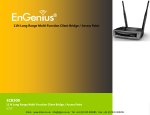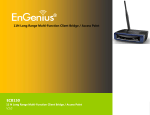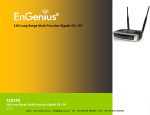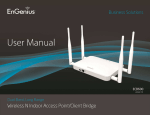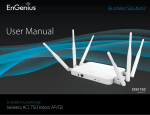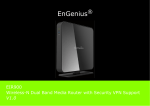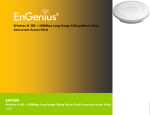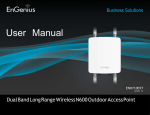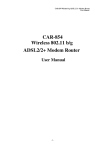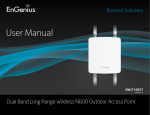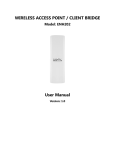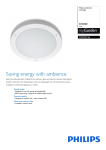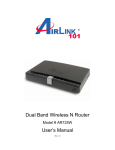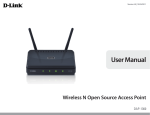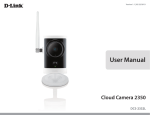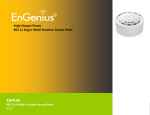Download EnGenius ECB300 WLAN access point
Transcript
1 11N Long Range Multi-Function Client Bridge / Access Point ECB300 11 N Long Range Multi-Function Client Bridge / Access Point V1.0 1 Table of Contents 1 Introduction ....................................................................................................................................................................... 6 1.1 1.2 1.3 1.4 2 Before you Begin ............................................................................................................................................................. 10 2.1 2.2 2.3 2.4 3 Default Settings ................................................................................................................................................................................................. 17 Web Configuration........................................................................................................................................................................................... 18 Building a Wireless Network ......................................................................................................................................... 20 4.1 4.2 4.3 4.4 4.5 4.6 5 Considerations for Wireless Installation .................................................................................................................................................. 10 Computer Settings (Windows XP/Windows Vista/Windows 7)...................................................................................................... 11 Apple Mac X OS................................................................................................................................................................................................. 14 Hardware Installation ...................................................................................................................................................................................... 15 Configuring Your Client Bridge ..................................................................................................................................... 17 3.1 3.2 4 Features and Benefits .........................................................................................................................................................................................6 Package Contents ................................................................................................................................................................................................7 System Requirements.........................................................................................................................................................................................8 Applications............................................................................................................................................................................................................8 Client Bridge Mode .......................................................................................................................................................................................... 20 Access Point Mode ........................................................................................................................................................................................... 21 WDS AP Mode.................................................................................................................................................................................................... 22 WDS Bridge Mode ............................................................................................................................................................................................ 23 Router Mode....................................................................................................................................................................................................... 24 Repeater Mode .................................................................................................................................................................................................. 25 System .............................................................................................................................................................................. 26 5.1 5.2 Operation Mode................................................................................................................................................................................................ 26 Status ..................................................................................................................................................................................................................... 28 2 5.3 5.4 5.5 5.6 6 Wireless ............................................................................................................................................................................ 38 6.1 6.2 6.3 6.4 6.5 6.6 6.7 6.8 6.9 6.10 7 DHCP...................................................................................................................................................................................................................... 32 Schedule ............................................................................................................................................................................................................... 34 Event Log.............................................................................................................................................................................................................. 36 Monitor ................................................................................................................................................................................................................. 37 Status ..................................................................................................................................................................................................................... 38 Basic........................................................................................................................................................................................................................ 40 Site Survey ........................................................................................................................................................................................................... 44 Advanced.............................................................................................................................................................................................................. 48 Security.................................................................................................................................................................................................................. 52 Filter........................................................................................................................................................................................................................ 58 WPS (Wi-Fi Protected Setup)........................................................................................................................................................................ 60 Client List .............................................................................................................................................................................................................. 62 VLAN ...................................................................................................................................................................................................................... 63 AP Profile .............................................................................................................................................................................................................. 64 Network............................................................................................................................................................................ 66 7.1 Status ..................................................................................................................................................................................................................... 66 7.2 LAN ......................................................................................................................................................................................................................... 67 7.3 Spanning Tree .................................................................................................................................................................................................... 70 7.4 WAN (Router mode) ........................................................................................................................................................................................ 71 7.4.1 Static IP Address....................................................................................................................................................................................... 71 7.4.2 Dynamic IP Address ................................................................................................................................................................................ 72 7.4.3 PPP over Ethernet (PPPoE) ................................................................................................................................................................... 73 7.4.4 Point-to-Point Tunneling Protocol (PPTP) ...................................................................................................................................... 74 8 Firewall ............................................................................................................................................................................. 76 8.1 Enable .................................................................................................................................................................................................................... 76 3 8.2 8.3 8.4 8.5 8.6 9 DMZ........................................................................................................................................................................................................................ 77 DoS.......................................................................................................................................................................................................................... 78 MAC Filter............................................................................................................................................................................................................. 79 IP Filter................................................................................................................................................................................................................... 80 URL Filter .............................................................................................................................................................................................................. 82 Advanced.......................................................................................................................................................................... 83 9.1 9.2 9.3 9.4 9.5 9.6 9.7 9.8 9.9 9.10 10 10.1 10.2 10.3 10.4 10.5 11 11.1 11.2 12 Network Address Translation (NAT).......................................................................................................................................................... 83 Port Mapping...................................................................................................................................................................................................... 84 Port Forwarding ................................................................................................................................................................................................. 85 Port Triggering ................................................................................................................................................................................................... 86 Application Layer Gateway (ALG) ............................................................................................................................................................... 87 Universal Plug and Play (UPnP) ................................................................................................................................................................... 88 Quality of Service (QoS) ................................................................................................................................................................................. 89 Static Routing ..................................................................................................................................................................................................... 92 Dynamic Routing............................................................................................................................................................................................... 93 Routing Table ..................................................................................................................................................................................................... 94 Management ................................................................................................................................................................ 95 Admin .................................................................................................................................................................................................................... 95 SNMP ..................................................................................................................................................................................................................... 97 Firmware Upgrade ............................................................................................................................................................................................ 99 Configure............................................................................................................................................................................................................102 Reset.....................................................................................................................................................................................................................103 Tools ............................................................................................................................................................................ 104 Time Setting ......................................................................................................................................................................................................104 Diagnosis ............................................................................................................................................................................................................105 Logout......................................................................................................................................................................... 106 4 Appendix A – FCC Interference Statement ........................................................................................................................ 107 Appendix B – IC Interference Statement ........................................................................................................................... 108 Appendix C – CE Interference Statement........................................................................................................................... 110 5 Revision History Version 1.0 Date Feb. 15, 2012 Notes First Release 6 1 Introduction The ECB300 is a multi-function 802.11b/g/n product with 6 major multi-functions. The ECB300 is designed to operate in every working environment including enterprises. The ECB300 is a Wireless Network device that delivers up to 6x faster speeds and 7x extended coverage than 802.11b/g devices. The ECB300 supports use in the home network with superior throughput, performance, and significant wireless range. To protect data during wireless transmissions, the ECB300 encrypts all wireless transmissions through WEP data encryption and supports WPA/WPA2 encryption. The ECB300 has MAC address filtering to allow users to select differing stations to access the network. The ECB300 is an ideal product to ensure network safety for both home and enterprise environments. 1.1 Features and Benefits Features Benefits High Speed Data Rate Up to 300 Mbps Capable of handling heavy data payloads such as HD multimedia streaming. 10/100 Fast Ethernet Support up to 100Mbps networking speed. IEEE 802.11n Draft Compliant and Backwards Compatible with 802.11b/g devices Fully compatible with IEEE 802.11b/g/n devices. Multi-Function Allowing users to select Access Point, Client Bridge, WDS AP, WDS Bridge, Router or Universal Repeater mode in various applications. Point-to-Point or Point-to-Multipoint Wireless Connectivity Allows transfer of data from building to building. 7 Support Multiple SSID in AP mode (up to 4) Allow clients to access different networks through a single access point and assign different policies and functions for each SSID through the built in software. WPA/WPA2/IEEE 802.1x Support Powerful data security. MAC Address Filtering in AP Mode Ensure a secure network connection. User Isolation Support (AP mode) Protect the private network between client users. Power-over-Ethernet (IEEE802.3af) Flexible Access Point locations. Save User Settings Firmware upgrade does not delete user settings. SNMP Remote Configuration Management Allows remote connection to configure or manage the ECB300 easily. QoS (WMM) support Enhanced user performance and density. 1.2 Package Contents The ECB300 package contains the following items (all items must be in package to issue a refund): ECB300 Wireless Long Range Multi-Function Client Bridge / Access Point 12V/1A 100V~240V Power Adapter RJ-45 Ethernet Cable Detachable Antenna CD with User’s Manual Quick Installation Guide 8 1.3 System Requirements The following are the minimum system requirements in order configure the device. Computer with an Ethernet interface or Wireless Network. Windows, Mac OS, or Linux based operating systems. Web-Browsing Application (example: Internet Explorer, FireFox, Safari, or other similar software) 1.4 Applications Wireless LAN products are easy to install and highly efficient. The following list describes some of the many applications made possible through the power and flexibility of wireless LANs: a) Difficult-to-Wire Environments There are many situations where wires cannot be laid easily or cannot be hidden from view. Older buildings, sites with multiple buildings, and/or areas make the installation of a Wired LAN impossible, impractical, and/or expensive. b) Temporary Workgroups Create temporary workgroups/networks in open areas such as parks, athletic arenas, exhibition centers, temporary offices, and construction sites where one wants a temporary Wireless LAN established and easily removed. c) The Ability to Access Real-Time Information Doctors/Nurses, Point-of-Sale Employees, and/or Warehouse Workers can access real-time information while dealing with patients, serving customers, and/or processing information. d) Frequently Changing Environments Set up networks in environments that change frequently (i.e.: Show Rooms, Exhibits, etc.). e) Small Office and Home Office (SOHO) Networks SOHO users need a cost-effective, easy and quick installation of a small network. 9 f) Wireless Extensions to Ethernet Networks Extend network coverage where the network cannot reach (i.e.: There is no wired internet connection to reach certain location of the environment). g) Wired LAN Backup Implement wireless LANs to provide backup for mission-critical applications running on wired networks. h) Training/Educational Facilities Training sites at corporations and students at universities use wireless connectivity to ease access to information, information exchanges, and learning. 10 2 Before you Begin This section will guide you through the installation process. Placement of the ENGENIUS ECB300 is essential to maximize the ECB300’s performance. Avoid placing the ECB300 in an enclosed space such as a closet, cabinet, or wardrobe. 2.1 Considerations for Wireless Installation The operating distance of all wireless devices cannot be pre-determined due to a number of unknown obstacles in the environment that the device is deployed in. These could be the number, thickness, and location of walls, ceilings, or other objects that the ECB300’s wireless signals must pass through. Here are some key guidelines to allow the ECB300 to have optimal wireless range. Keep the number of walls and/or ceilings between the ECB300 and other network devices to a minimum. Each wall and/or ceiling can reduce the signal strength, resulting in lower signal strength. Building materials makes a difference. A solid metal door and/or aluminum stubs may have a significant negative effect on the signal strength of the ECB300. Locate your wireless devices carefully so the signal can pass through a drywall and/or open doorways. Materials such as glass, steel, metal, concrete, water (example: fish tanks), mirrors, file cabinets, and/or brick can also lower your wireless signal strength. Interferences can also come from other electrical devices and/or appliances that generate RF noise. The most usual types are microwaves and cordless phones. 11 2.2 Computer Settings (Windows XP/Windows Vista/Windows 7) In order to use the ECB300, you must first configure the TCP/IPv4 connection of your computer system. Click Start button and select Control Panel. Windows XP Windows Vista/Windows 7 12 In Windows XP, click Network Connections In Windows 7, click View Network Status and Tasks in the Network and Internet section, then select Change Adapter Settings Right click on Local Area Connection and select Properties 13 Highlight Internet Protocol Version 4 (TCP/IPv4) and select Properties Select Use the following IP address and enter IP address and subnet mask then press OK. Note: Ensure that the IP address and subnet mask are on the same subnet as the device. For example: Device IP address: 192.168.1.1 PC IP address: 192.168.1.2 - 192.168.1.254 PC subnet mask: 255.255.255.0 14 2.3 Apple Mac X OS Open the System Preferences (can be opened in the Applications folder or selecting it in the Apple Menu) Select Network in the Internet & Network section Highlight Ethernet In Configure IPv4, select Manually Enter IP address and subnet mask then press OK. Note: Ensure that the IP address and subnet mask are on the same subnet as the device. For example: Device IP address: 192.168.1.1 PC IP address: 192.168.1.2 - 192.168.1.254 PC subnet mask: 255.255.255.0 Click Apply when done. 15 2.4 Hardware Installation 1) Ensure that the computer in use has an Ethernet Card (RJ-45 Ethernet Port). For more information, verify with our computer user manual. 2) Connect one end of the Category 5 Ethernet cable into RJ-45 port of the ECB300 and the other end to the RJ-45 port on the computer that will use the ECB300. Ensure that the cable is securely connected to both the ECB300 and the Computer. 3) Connect the Power Adaptor DC Inlet to the DC-IN port of the ECB300 and the Power Adaptor to the electrical out. Once both connections are secure, verify the following: a) Ensure that the Power light is on (it will be blue). b) Ensure that the Wireless light is on (it will be blue). c) Ensure that the LAN (Computer/ECB300 Connection) light is on (it will be blue). d) Once all three lights are on, proceed to setting up the computer. This diagram depicts the hardware configuration. 16 Front Panel Rear Panel Front Panel LED Lights LED lights for Wireless, Ethernet port and Power. Rear Panel DC IN DC IN for Power. Reset Button One click for reset the device. Press over 10 seconds for reset to factory default. Ethernet Port Ethernet port for RJ-45 cable. 17 3 Configuring Your Client Bridge This section will show you how to configure the device using the web-based configuration interface. 3.1 Default Settings Please use your Ethernet port or wireless network adapter to connect the Client Bridge. Default Settings IP Address 192.168.1.1 Username / Password admin / admin Operation Mode Client Bridge 18 3.2 Web Configuration Open a web browser (Internet Explorer/Firefox/Safari) and enter the IP Address: http://192.168.1.1 Note: If you have changed the default LAN IP Address of the device, ensure you enter the correct IP Address. The default username and password are admin. Once you have entered the correct username and password, click the Login button to open the web-base configuration page. 19 If successful, you will be logging in and see the ECB300 User Menu 20 4 Building a Wireless Network The ECB300 has the ability to operate in various operating modes. The ECB300 is the ideal device in which you can build your WLAN. This chapter describes how to build a WLAN around your ECB300 using the operating modes of the ECB300. 4.1 Client Bridge Mode In Client Bridge Mode, the ECB300 acts as a wireless dongle that connects to an Access Point to allow a system wireless access to the network. This mode requires you to connect the Ethernet port on your PC to the ECB300 LAN port. If you use the client bridge operating mode, use the ECB300 Site Survey feature to scan for Access Points within range. When you find an Access Point, configure the ECB300 to use the same SSID and Security Password as the Access Point to associate with it. 21 4.2 Access Point Mode In Access Point Mode, ECB300 behaves likes a central connection for stations or clients that support IEEE 802.11b/g/n networks. The stations and clients must be configured to use the same SSID and security password to associate with the ECB300. The ECB300 supports up to four SSIDs at the same time for secure guest access. 22 4.3 WDS AP Mode The ECB300 also supports WDS AP mode. This operating mode allows wireless connections to the ECB300 using WDS technology. In this mode, configure the MAC addresses in both Access Points to enlarge the wireless area by enabling WDS Link settings. WDS supports four AP MAC addresses. 23 4.4 WDS Bridge Mode In WDS Bridge Mode, the ECB300 can wirelessly connect different LANs by configuring the MAC address and security settings of each ECB300 device. Use this mode when two wired LANs located a small distance apart want to communicate with each other. The best solution is to use the ECB300 to wirelessly connect two wired LANs, as shown in the following figure. WDS Bridge Mode can establish four WDS links, creating a star-like network. Note: WDS Bridge Mode does not act as an Access Point. Access Points linked by WDS are using the same frequency channel. More Access Points connected together may lower throughput. Please be aware to avoid loops in your wireless connection, otherwise enable Spanning Tree Function. 24 4.5 Router Mode In Access Point Router Mode, ECB300 grants Internet access to multiple wireless clients. In this mode, the ECB300’s internal Dynamic Host Configuration Protocol (DHCP) server automatically allocates ranges of IP addresses to each wireless client that will access the Internet through the ECB300. This mode requires you to connect the ECB300’s Ethernet port to a modem or router. And the wireless clients must be configured to use the same SSID and security password to associate with the ECB300. The ECB300 supports up to four SSIDs at the same time for secure guest access. 25 4.6 Repeater Mode Repeater is used to regenerate or replicate signals that are weakened or distorted by transmission over long distances and through areas with high levels of electromagnetic interference (EMI). 26 5 System 5.1 Operation Mode Each operating mode offers different features. In order to switch the operating mode, select it from the Operation Mode from the System Menu. There are six operation modes: Access Point, Client Bridge, WDS AP, WDS Bridge, Access Point Router and Universal Repeater. A dialog box will appear to notify you that the system will restart in order for the changes to take effect. Click on the OK button to continue. 27 The ECB300 will display how much time it will take to restart the device in the new operating mode as shown below. 28 5.2 Status This page will display status of the device. System Operation Mode Displays the current mode of operation of the ECB300. System Time Displays the current time of the ECB300. System Up Time The elapsed time of operation of the ECB300. Hardware Version and Serial Number Hardware information of the ECB300. Firmware Version The current firmware version of the ECB300. 29 WAN Settings (Router mode) Attain IP Protocol Method used to connect to the Internet. This is your WAN connection type. IP Address The WAN IP address of the Router. Subnet Mask The WAN subnet mask of the Router. Default Gateway The default gateway of the Router. MAC Address The WAN MAC address of the Router. Primary and Secondary DNS The IP addresses of the Primary and Secondary DNS servers assigned to the WAN connection. 30 WLAN Station Information (Client Bridge mode) Connection Status The connection status: Successful or Fail. Channel The wireless channel in use. ESSID The SSID (Network Name) of the wireless network which ECB300 connected. Security The wireless encryption in use. BSSID The MAC address of this SSID which ECB300 connected. WLAN Repeater Information (Repeater mode) Connection Status The connection status: Successful or Fail. Channel The wireless channel in use. ESSID The SSID (Network Name) of the wireless network. 31 Security Wireless encryption for this SSID. BSSID The MAC address of this SSID. WLAN Settings (Access Point / WDS AP / Repeater / Router mode) Channel Displays the current Wireless Channel in use by the ECB300. ESSID The SSID (Network Name) of the wireless network (up to 4 SSIDs supported). Security Current wireless encryption for the corresponding SSID. BSSID The MAC address of the corresponding SSID. 32 5.3 DHCP The DHCP option in the System menu displays the client IP address assigned by the DHCP Server. You can also set the IP Addresses of the connected devices manually. Note: Only in Access Point / Router mode. 33 The DHCP Client Table shows the LAN clients that have been allocated an IP address from the DHCP Server. DHCP Client Table IP address Displays the IP Address of the client on the LAN. MAC address Displays the MAC Address of the client on the LAN. Expiration Time Displays the time of expiration of the IP Address of the client. Refresh Click this button to update the DHCP Client Table. 34 5.4 Schedule The Schedule option of the System menu allows you to set a schedule when the ECB300’s Wireless is active. The Schedule Table will display: NO.: The entry number of the schedule. Description: The name given to the schedule. Service: Displays whether the wireless service will be activate or not during the scheduled time. Schedule: Displays when the schedule will execute. You will also be able to Add new schedules (at most 10), Edit schedules, Delete Selected schedules, or Delete All schedules. 35 After selecting Add or Edit, the following form will show up. Fill in the form to set the schedule you want. Schedule Schedule Description Assign a name to the schedule. Service The service provided for the schedule. Days Set which days the schedule will be active. Time of day Set what time of the selected days the schedule will be active. 36 5.5 Event Log The Event Log of the System menu displays the system events and actions of the ECB300. When powered down or rebooted, the Event Log will be cleared. Event Log Save Save the log to a .txt file. Clear Clear the log. Refresh Update the log. 37 5.6 Monitor The Monitor option of the System menu displays 2 histogram graphs. The histograms represent the bandwidth usage of both the daily use of the Ethernet and the daily use of the WLAN. If you click on Detail, a new browser window will open with 4 additional histograms (6 total). In the new browser window, you will be able to view the weekly and monthly bandwidth usage for both the Ethernet and WLAN. 38 6 Wireless 6.1 Status The Status of the Wireless menu displays the current status of the ECB300's wireless configuration. Client Bridge mode: Access Point / Router mode: 39 Repeater mode: 40 6.2 Basic The Basic option of the Wireless menu displays the basic wireless options of the ECB300. Client Bridge: Basic (Client Bridge mode) Radio Enable or Disable the device’s wireless signal. Band Select the types of wireless clients that the device will accept. Site Survey Click on [Site Survey] to search the existing AP. 41 Access Point / Router mode: Basic (Access Point / Router mode) Radio Enable or Disable the ECB300’s wireless signal. Mode Select between Access Point or Wireless Distribution System (WDS) modes. Band Select the types of wireless clients that the device will accept. Enable SSID# Select the number of SSID’s (Wireless Network names) you would like (up to 4). SSID# Enter the name of your wireless network. You can use up to 32 characters. Auto Channel When enabled, the device will scan the wireless signals around your area and select the channel with the least interference. Channel Manually select which channel the wireless signal will use. 42 Check Channel Time When Auto Channel is Enabled, you can specify the period of device will scan the wireless signals around your area. WDS AP / WDS Bridge mode: Wireless Distribution System (WDS) Using a WDS to connect Access Points wirelessly extends a wired infrastructure to locations where cabling is not possible or inefficient to implement. Note: Compatibility between different brands and models of Access Points is not guaranteed. It is recommended that a WDS network be created using the same Access Point models for maximum compatibility. Also, all Access Points in the WDS network need to use the same Channel and Security settings. To create a WDS network, please enter the MAC addresses of the Access Points that you want included in the WDS. There can be a maximum of four access points. 43 Repeater mode: Basic (Repeater mode) Radio Enable or Disable the device’s wireless signal. Band Select the types of wireless clients that the device will accept. eg: 2.4 Ghz (B+G) Only 802.11b and 11g clients will be allowed. ESSID1 Enter the name of your wireless network. You can use up to 32 characters. Site Survey Click on [Site Survey] to search the existing AP. 44 6.3 Site Survey Client Bridge mode: 1. AP list after site survey. 2. Select an AP and click on [Add to AP Profile]. 45 3. Enter the correct security setting. 4. Add AP profile successfully, click on [Close] to close the browser. 5. The AP profile is added in AP Profile Table. 46 Repeater mode: 1. AP list after site survey. 2. Select an AP and click on [Connect]. 3. Enter the correct security setting. 47 4. Connect AP successfully, click on [Close] to close the browser. 5. You can see the Connection Status in Status WEB page. 48 6.4 Advanced The Advanced option of the Wireless menu displays the advanced wireless options of the ECB300. It is recommended that the ECB300’s default settings are used unless the user has experience with advanced networking. Client Bridge mode: Advanced (Client Bridge mode) Fragment Threshold Specifies the maximum size of the packet per fragment. This function can reduce the chance of packet collision. However, when the fragment threshold is set too low, there will be increased overhead resulting in poor performance. RTS Threshold When the packet size is smaller than the RTS Threshold, the packet will be sent without an RTS/CTS handshake, which may result in incorrect transmission. 49 Access Point / WDS AP / Router / Repeater mode: Advanced (Access Point / WDS AP / Router / Repeater mode) Fragment Threshold Specifies the maximum size of the packet per fragment. This function can reduce the chance of packet collision. However, when the fragment threshold is set too low, there will be increased overhead resulting in poor performance. RTS Threshold When the packet size is smaller than the RTS Threshold, the packet will be sent without an RTS/CTS handshake, which may result in incorrect transmission. Beacon Interval The time interval that the device broadcasts a beacon. This beacon is used to synchronize all wireless clients on the network. 50 DTIM Period A Delivery Traffic Indication Message (DTIM) informs all wireless clients that the access point will be transmitting Multi-casted data. N Data Rate You can limit the transfer rates between the device and wireless clients. Each Modulation Coding Scheme (MCS) refers to a specific transfer speed. Channel Bandwidth Set whether each channel uses 20Mhz or 40Mhz transmission frequency. To achieve 11n speeds, 40Mhz channels must be used. Preamble Type A preamble is a message that helps access points synchronize with the client. Long Preamble is standard based so increases compatibility. Short Preamble is non-standard, resulting in decreased compatibility, but increased performance. Tx Power Set the power output of the wireless signal. WDS Bridge mode: 51 Advanced (WDS Bridge mode) Fragment Threshold Specifies the maximum size of the packet per fragment. This function can reduce the chance of packet collision. However, when the fragment threshold is set too low, there will be increased overhead resulting in poor performance. RTS Threshold When the packet size is smaller than the RTS Threshold, the packet will be sent without an RTS/CTS handshake, which may result in incorrect transmission. N Data Rate You can limit the transfer rates between the device and wireless clients. Each Modulation Coding Scheme (MCS) refers to a specific transfer speed. Channel Bandwidth Set whether each channel uses 20Mhz or 40Mhz transmission frequency. To achieve 11n speeds, 40Mhz channels must be used. Preamble Type A preamble is a message that helps access points synchronize with the client. Long Preamble is standard based so increases compatibility. Short Preamble is non-standard, resulting in decreased compatibility, but increased performance. Tx Power Set the power output of the wireless signal. 52 6.5 Security The Security option in the Wireless menu allows you to set the wireless security settings. Note: Only in Access Point / WDS AP / Router and Repeater mode. Security (Access Point / WDS AP / Router / Repeater mode) SSID Selection Select the SSID that the corresponding security settings will apply to. Separate Separating the SSID from each other (or use of STA) prevents communication and data sharing between wireless stations associated with the SSIDs. Broadcast SSID If Disabled, the ECB300 will not broadcast the SSID. It will be invisible to the clients. WMM Wi-Fi Multi-Media is a Quality of Service protocol which prioritizes traffic in the order according to voice, video, best effort, and background. Note: In certain situations, WMM needs to be enabled to achieve 11n transfer speeds. 53 Encryption The encryption method to be used on the corresponding SSID. You can choose between WEP, WPA Pre-Shared Key, or WPA RADIUS. Disabled - No data encryption is used. WEP - Data is encrypted using the WEP standard. WEP is the Wired Equivalent Privacy security over a wireless network. WPA-PSK - Data is encrypted using the WPA-PSK standard. This is a later standard than WEP, and provides much better security than WEP. WPA-PSK is Wi-Fi Protected Access using a Pre-Shared Key. This is the equivalent of password protecting your wireless network. WPA2-PSK - This is a further development of WPA-PSK, and offers even greater security, using the AES (Advanced Encryption Standard) method of encryption. WPA-RADIUS - This version of WPA requires a Radius Server on your LAN to provide the client authentication according to the 802.1x standard. Data transmissions are encrypted using the WPA standard. If this option is selected: This Access Point must have a Client Login on the Radius Server. Each user must have a User Login on the Radius Server. Each user's wireless client must support 802.1x and provide the login data when required. All data transmission is encrypted using the WPA standard. Keys are automatically generated, so no key input is required. IEEE 802.1x is an authentication protocol. Every user must use a valid account to login to this Access Point before accessing the wireless LAN. The authentication is then processed by a RADIUS server. This mode only authenticates users by IEEE 802.1x, but it does not encrypt the data during communication. 54 802.1x Authentication RADIUS Server IP Address The IP Address of the RADIUS Server. RADIUS Server port The port number of the RADIUS Server. RADIUS Server password The RADIUS Server password. 55 WEP Encryption: WEP Encryption Authentication Type Please ensure that your wireless clients use the same authentication type. Key type ASCII: Using characters from the ASCII standard (recommended) HEX: Uses hexadecimal characters. Key Length The amount of bits the WEP key will use. 64 Bit - data is encrypted, using the default key, before being transmitted. You must enter at least the default key. For 64 Bit Encryption, the key size is 10 chars in HEX (0~9 and A~F). 128 Bit - data is encrypted, using the default key, before being transmitted. You must enter at least the default key. For 128 Bit Encryption, the key size is 26 chars in HEX (0~9 and A~F). Default Key Select the key you wish to be the default. Transmitted data is ALWAYS encrypted using the Default Key; the other Keys are for decryption only. You must enter a Key Value for the Default Key. Encryption Key # Enter the key value or values you wish to use. Only the Key selected as Default is required. The others are optional. 56 WPA Pre-Shared Key Encryption: WPA Pre-Shared Key Encryption WPA type Select the WPA encryption you would like. Please ensure that your wireless clients use the same settings. WPA(TKIP): Uses a Pre-Shared Key with a dynamically generated key for each 128-bit packet. WPA2(AES): Government standard of WPA2 encryption. WPA2 Mixed: Allows the use of both WPA and WPA2 clients on the network. Pre-shared Key Type Pre-Shared Key format (ASCII or Hexadecimal). Pre-shared Key Wireless clients must use the same key to associate the device to the ECB300. If using passphrase format, the Key must be from 8 to 63 characters in length. 57 WPA RADIUS Encryption: WPA RADIUS Encryption WPA type Select the WPA encryption you would like. Please ensure that your wireless clients use the same settings. WPA(TKIP): Uses a Pre-Shared Key with a dynamically generated key for each 128-bit packet. WPA2(AES): Government standard of WPA2 encryption. WPA2 Mixed: Allows the use of both WPA and WPA2 clients on the network. RADIUS Server IP address Enter the IP address of the RADIUS Server. RADIUS Server Port Enter the port number used for connections to the RADIUS server. RADIUS Server password Enter the password required to connect to the RADIUS server. 58 6.6 Filter The Filter option in the Wireless menu allows users to allow clients with specific MAC Addresses to join the SSID. Note: Only in Access Point / WDS AP / Router and Repeater mode. Wireless MAC Filter (Access Point / WDS AP / Router / Repeater mode) Enable Wireless Access Control Enable Wireless Access Control. When Enabled, only wireless clients on the Filtering Table will be allowed. Description Enter a name or description for this entry. MAC Address Enter the MAC address of the wireless client that you wish to allow connection. 59 Add Click this button to add the entry. Reset Click this button if you have made a mistake and want to reset the MAC address and Description fields. MAC Address Filtering Table Only clients listed in this table will be allowed access to the wireless network. Delete Selected Delete the selected entries. Delete All Delete all entries. Reset Deselect all entries. 60 6.7 WPS (Wi-Fi Protected Setup) The WPS feature in the Wireless menu follows the Wi-Fi Alliance WPS standard. It eases the set up of security-enabled Wi-Fi networks in homes and/or small office environments. It reduces the user steps required to configure a network and supports two methods that are familiar to most consumers to configure a network and enable security. Note: Only in Access Point / WDS AP and Router mode. Wi-Fi Protected Setup (WPS) WPS Check to Enable the WPS feature. Wi-Fi Protected Setup Information WPS Current Status Shows whether the WPS function is Configured or Un-configured. Configured means that WPS has been used to authorize connection between the ECB300 and the wireless clients. 61 SSID The SSID (network name) used when connecting using WPS. Authentication Mode Shows the encryption method used by the WPS process. This is set as the mode selected in the Security option in the Wireless menu. Passphrase Key This is the passphrase key that is randomly generated during the WPS process. It is required if wireless clients that do not support WPS attempts to connect to the wireless network. WPS Via Push Button Activate WPS using a push button. WPS Via PIN Activate WPS using the PIN code from the WPS device. 62 6.8 Client List The Client List option of the Wireless menu shows all the wireless clients that are currently connected to the ECB300. Note: Only in Access Point / WDS AP / Router and Repeater mode. 63 6.9 VLAN The VLAN option of the Wireless menu allows you to configure the VLAN (Virtual LAN). Note: Only in Access Point mode. VLAN (Access Point and WDS AP mode) Virtual LAN Choose to Enable or Disable the VLAN feature. SSID# Tag Specify the VLAN tag for each SSID. LAN VLAN MGMT Choose to Enable or Disable the LAN VLAN MGMT feature. MGMT Tag Specify the VLAN tag for the LAN. 64 6.10 AP Profile This page allows you to configure the profile of the Client Bridge including Security Setting exactly the same as the Access Point. You can save three AP profiles at most. Note: Only in Client Bridge mode. AP Profile Table (Client Bridge mode) Add / Edit Select a profile to add or edit. Move Up / Move Down Select a profile to move up or move down. Delete Selected Delete the selected entries. Delete All Delete all entries Connect Select a profile to connect. 65 AP Profile Settings Network Name (SSID) Enter the SSID (Network Name) of the wireless network which ERB9260 want to connect. Encryption The encryption method to be applied. You can choose from Disable, WEP, WPA pre-shared key and RADIUS. Please select the correct security type. 66 7 Network 7.1 Status The Status option of the Network menu shows the current status of the ECB300’s LAN and WAN (Router mode) connection. 67 7.2 LAN The LAN option of the Network menu allows you to modify the device's LAN settings. The LAN setting in Router mode: There is additional setting Default Gateway in Access Point / Client Bridge / WDS AP / WDS Bridge and Repeater mode. 68 LAN IP Bridge Type Select the Bridge type of the LAN. Static IP: Manually specify an IP address and subnet mask for the ECB300 to use. Dynamic IP: The IP address is received automatically from the external DHCP server. Note: The option: Dynamic IP is only in Access Point and WDS AP mode. IP Address The LAN IP Address of this device. IP Subnet Mask The LAN Subnet Mask of this device. Default Gateway The Default Gateway of the device. Leave empty for default setting. Note: The option: Dynamic IP is only in Access Point / Client Bridge / WDS AP / WDS Bridge and Repeater mode. DNS Type Select the DNS type of the LAN. Static: Manually specify the DNS of the ECB300. Dynamic: The DNS is received automatically from the external DNS server. Note: The option: Dynamic is only in Access Point and WDS AP mode. First / Second DNS Address The first / second DNS address for this device. 69 The DHCP Server feature is only available in Access Point and Router mode. DHCP Server (Access Point / Router mode) DHCP Server Enable or disable DHCP feature. The DHCP Server automatically allocates IP addresses to your LAN device. Disabled as default. Lease Time The duration of the DHCP server allocates each IP address to a LAN device. Start / End IP The range of IP addresses of the DHCP server will allocate to LAN device. Domain name The domain name for this LAN network. First / Second DNS Address The first / second DNS address for this LAN network. 70 7.3 Spanning Tree The Spanning Tree option of the Network menu allows you to set the ECB300 to use the Spanning Tree Protocol. Enabling Spanning Tree Protocol will prevent network loops in your LAN network. Note: Only in Access Point / Client Bridge / WDS AP / WDS Bridge and Repeater mode. Spanning Tree Settings Spanning Tree Status Enable or disable the Spanning Tree Protocol. Bridge Hello Time The duration of the initial connection between two access points. Bridge Max Age The maximum amount of time the bridge is connected when transmitting. Bridge Forward Delay The delay between transmissions between access points. Bridge Priority The priority port of the Spanning Tree Protocol. 71 7.4 WAN (Router mode) The WAN section allows you to manually set the WAN type connection and its related settings. Note: Only in Router mode. 7.4.1 Static IP Address If your ISP Provider has assigned you a fixed IP address, enter the assigned IP address, Subnet mask, Default Gateway IP address, and Primary DNS and Secondary DNS (if available) of your ISP provider. Static IP Address IP Address Assign an IP address Manually. IP Subnet Mask Specify an IP address’s subnet mask. Default Gateway Specify the gateway of your network. Primary DNS Specify the primary DNS server’s IP address. Secondary DNS Specify the second DNS server’s IP address. 72 7.4.2 Dynamic IP Address The IP Address is allocated automatically. However some ISP’s will also recognize the MAC address and will reject connections if the MAC address does not match. If your ISP has recorded the MAC address of your computer’s Ethernet LAN card, please connect only the computer with the authorized MAC address, and click the Clone MAC button. Note: This will replace the WAN MAC address to the computer MAC address. The correct MAC address is used to initiate the connection to the ISP. Dynamic IP Address Hostname This is optional. Only required if specified by ISP MAC Address The MAC Address that is used to connect to the ISP. 73 7.4.3 PPP over Ethernet (PPPoE) This protocol is used by most DSL services worldwide. Select this option if you have a DSL connection. Enter the username and password provided by your ISP. PPP over Ethernet (PPPoE) Login Username assigned to you by the ISP Password Password for this username. Service Name You can assign a name for this service. (Optional) MTU The maximum size of packets. Do not change unless mentioned by the ISP. Type You can choose the method that the router maintains connection with the ISP. Keep Connection: The device will maintain a constant connection with the ISP. Automatic Connection: The device will only initiate connection to the ISP when there is an Internet connection request made from a LAN device. Manual Connection: The user will need to manually connect to the ISP by clicking the Connect button. Idle Timeout: When the connection type is Automatic Connection, when Internet traffic is idle, then the device will automatically disconnect from the ISP. Please specify the Idle time in minutes. 74 7.4.4 Point-to-Point Tunneling Protocol (PPTP) PPTP is used by very few ISPs. 75 Point-to-Point Tunneling Protocol (PPTP) WAN Interface Type Select whether the ISP is set to Static IP or will allocate Dynamic IP address. Hostname This is optional. Only required if specified by ISP MAC address The MAC Address that is used to connect to the ISP. Login Username assigned to you by the ISP Password Password for this username. Service IP Address The IP Address of the PPTP server. Connection ID This is optional. Only required if specified by ISP MTU The maximum size of packets. Do not change unless mentioned by the ISP. Type You can choose the method that the router maintains connection with the ISP. Keep Connection: The device will maintain a constant connection with the ISP. Automatic Connection: The device will only initiate connection to the ISP when there is an Internet connection request made from a LAN device. Manual Connection: The user will need to manually connect to the ISP by clicking the Connect button. Idle Timeout: When the connection type is Automatic Connection, when Internet traffic is idle, then the device will automatically disconnect from the ISP. Please specify the Idle time in minutes. 76 8 Firewall The Firewall section allows you to set the access control and Firewall settings. Note: Only in Router mode. 8.1 Enable This page allows you to Enable / Disable the Firewall features. If enabled Firewall service, the Denial of Service (DoS) and SPI (Stateful Packet Inspection) features will also be enabled. 77 8.2 DMZ If enabled this feature, allows the DMZ computer on your LAN to be exposed to all users on the Internet. This allows almost any application to be used on the server. The “DMZ PC” will receive all Unknown connections and data. If the DMZ feature is enabled, please enter the IP address of the PC to be used as the “DMZ PC” Note: The “DMZ PC” is effectively outside the Firewall, making it more vulnerable to attacks. For this reason, you should only enable the DMZ feature when required. 78 8.3 DoS Denial of Service (Denial of Service) is a type of Internet attack that sends a high amount of data to you with the intent to overload your Internet connection. Enable the DoS firewall feature to automatically detect and block these DoS attacks. 79 8.4 MAC Filter You can choose whether to Deny or only Allow those computers listed in the MAC Filtering table to access the Internet. MAC Filter Enable MAC filtering Tick this box to Enable the MAC filtering feature. Deny all clients with MAC addresses listed below to access the network When selected, the computers listed in the MAC Filtering table will be Denied access to the Internet. Allow all clients with MAC addresses listed below to access the network When selected, only the computers listed in the MAC Filtering table will be Allowed access to the Internet. 80 8.5 IP Filter You can choose whether to Deny or only Allow, computer with those IP Addresses from accessing certain Ports. This can be used to control which Internet applications the computers can access. You may need to have certain knowledge of what Internet ports the applications use. 81 IP Filter Enable IP filtering Tick this box to Enable the IP filtering feature. Deny all clients with IP addresses listed below to access the network When selected, the computers with IP addresses specified will be Denied access to the indicated Internet ports. Allow all clients with IP addresses listed below to access the network When selected, the computers with IP addresses specified will be Allowed access only to the indicated Internet ports. 82 8.6 URL Filter You can deny access to certain websites by blocking keywords in the URL web address. For example, “gamer” has been added to the URL Blocking Table. Any web address that includes “gamer” will be blocked. 83 9 Advanced The Advanced section allows you to configure the Advanced settings of the router. Note: Only in Access Point Client Router mode. 9.1 Network Address Translation (NAT) This page allows you to Enable / Disable the Network Address Translation (NAT) feature. The NAT is required to share one Internet account with multiple LAN users. 84 9.2 Port Mapping Port Mapping allows you to redirect a particular range of ports to a computer on your LAN network. This helps you host servers behind the NAT and Firewall. In the example below, there is a FTP Server that requires ports 21 to 22. When there is a connection from the Internet on those ports, it will be redirected to the FTP Server at IP address 192.168.1.100. Port Mapping Enable Port Mapping Check this box to enable the Port Mapping feature. Description Enter a name or description for this entry. Local IP The local IP address of the computer the server is hosted on. Protocol Select to apply the feature to TCP, UDP or Both types of packet transmissions. Port Range The range of ports that this feature will be applied to. 85 9.3 Port Forwarding Port Forwarding allows you to redirect a particular public port to a computer on your LAN network. This helps you host servers behind the NAT and Firewall. In the example below, there is a Web Server running on port 80 on the LAN. For security reasons, the Administrator would like to provide this server to Internet connection on port 100. Therefore when there is a connection from the Internet on port 100, it will be forwarded to the computer with the IP address 192.168.1.150 and changed to port 80. Port Forwarding Enable Port Forwarding Check this box to enable the Port Forwarding feature. Description Enter a name or description for this entry. Local IP The local IP address of the computer the server is hosted on. Protocol Select to apply the feature to TCP, UDP or Both types of packet transmissions. Local Port The port that the server is running on the local computer. Forwarded Port When a connection from the Internet is on this port, it will be forwarded to the indicated local IP address. 86 9.4 Port Triggering If you use Internet applications which use non-standard connections or port numbers, you may find that they do not function correctly because they are blocked by the Wireless Router's firewall. Port Triggering will be required for these applications to work. Port Triggering Enable Port Triggering Check this box to enable the Port Trigger feature. Popular Applications This is a list of some common applications with preset settings. Select the application and click Add to automatically enter the settings. Trigger Port This is the outgoing (outbound) port numbers for this application. Trigger Type Select whether the application uses TCP, UDP or Both types of protocols for outbound transmissions. Forwarded Port These are the inbound (incoming) ports for this application. Public Type Select whether the application uses TCP, UDP or Both types of protocols for inbound transmissions. 87 9.5 Application Layer Gateway (ALG) Certain applications may require the use of the ALG feature to function correctly. If you use any of the applications listed on the table below, select the feature and click Apply. 88 9.6 Universal Plug and Play (UPnP) The UPnP function allows automatic discovery and configuration of UPnP enabled devices on your network. It also provides automatic port forwarding for supported applications to seamlessly bypass the Firewall. 89 9.7 Quality of Service (QoS) QoS allows you to control the priority that the data is transmitted over the Internet, or to reserve a specific amount of Internet bandwidth. This is to ensure that applications get enough Internet bandwidth for a good user experience. QoS Priority Queue Sets the QoS method to Priority Queue. Bandwidth Allocation Sets the QoS method to Bandwidth Allocation. Disabled Disables the QoS feature. 90 Priority Queue Method Bandwidth priority is set to either High or Low. The data transmissions in the High Priority queues will be processed first. Unlimited Priority Queue IP Address The computer with this IP Address will not be bound by the QoS rules. High / Low Priority Queue Protocol The type of network protocol. High / Low Priority Sets the protocol to High or Low priority. Specific Port Each protocol uses a specific port range. Please specify the ports used by this protocol. 91 Bandwidth Allocation Method You can set the maximum amount of bandwidth a certain protocol will use at one time. Or you can set a minimum amount of bandwidth that will be guaranteed to a certain protocol. Bandwidth Allocation Type Set whether the QoS rules apply to transmission that are Download, Upload or Both directions. IP range Enter the IP address range of the computers that you would like the QoS rules to apply to. Protocol Select from this list of protocols to automatically set the related port numbers. Port Range Each protocol uses a specific port range. Specify the ports used by this protocol. Policy Choose whether this rule is to set a limit on the Maximum amount of bandwidth allocated to the specified protocol, or to set the guaranteed Minimum amount of bandwidth for the protocol. 92 9.8 Static Routing If your wireless router is connected to a network with different subnets, this feature will allow the different subnets to communicate with each other. Note: The NAT function needs to be disabled for the Routing feature to be enabled. Static Routing Enable Static Routing Check this box to enable the Static Router feature. Destination LAN IP Enter the IP address of the destination LAN. Subnet Mask Enter the Subnet Mask of the destination LAN IP address Default Gateway Enter the IP address of the Default Gateway for this destination IP and Subnet. 93 9.9 Dynamic Routing Dynamic routing allows routing tables in routers to change as the possible routes change. This device use RIP to support dynamic routing. 94 9.10 Routing Table This page allows you to observe the current routing table. 95 10 Management 10.1 Admin The Admin section of the Management menu allows you to change the ECB300 default password and to configure remote management (Router mode). By default, the password is: admin. The password can contain 0 to 12 alphanumeric characters and is case sensitive. Change Password Old Password Enter the current password. New Password Enter your new password. Confirm Password Re-enter your new password. Idle Timeout Enter Administration Page timeout time (minutes). 96 There is additional setting Remote Management in Router mode. Remote Management (Router mode) Host Address You can only perform remote management from the specified IP address. Leave blank to allow any host to perform remote management. Port Enter the port number you want to accept remote management connections. Enable Tick to Enable the remote management feature. 97 10.2 SNMP The SNMP section of the Management menu allows you to assign the contact details, location, community name, and trap settings for the Simple Network Management Protocol (SNMP). The SNMP is a networking management protocol used to monitor network-attached devices. SNMP allows messages (called protocol data units) to be sent to various parts of a network. Upon receiving these messages, SNMP-compatible devices (Agents) return data stored in their Management Information Bases. 98 SNMP SNMP Active Enable or disable the SNMP feature. SNMP Version You may select the SNMP version you want to deploy. All: Interoperability between SNMPv1 and SNMPv2c devices. v1: The standard SNMP version. v2c: Improvement in performance and security of SNMPv1. Read Community Specify the password for access the SNMP community for read only access. Set Community Specify the password for access to the SNMP community with read/write access. System Location Specify the location of the device. System Contact Specify the contact details of the device Trap Trap Active Enable or disable SNMP trapping feature. Trap Manager IP Specify the IP address of the computer that will receive the SNMP traps. Trap Community Specify the password for the SNMP trap community. 99 10.3 Firmware Upgrade The Firmware Upgrade section of the Management allows you to upgrade the ECB300's firmware. To perform the Firmware Upgrade: 1. Download the firmware version that you want to install into the ECB300 and place it in a known location. 2. Click the Browse button and navigate to the location of the firmware upgrade file. 3. Select the firmware upgrade file. Its name will appear in the Upgrade File field. 4. Click the Apply button to commence the firmware upgrade. Note: The device is unavailable during the upgrade process, and must restart when the upgrade is completed. Any connections to or through the device will be lost. 100 Emergency Upgrade If your firmware upgrade failed, you may enter the Emergency Upgrade WEB page. 1. Enter IP address: 192.168.99.9 and enter Emergency Upgrade WEB page. Note: Refer to 2.2 to configure PC/Notebook IP address to 192.168.99.8. 2. Click the Browse button and navigate to the location of the upgrade file and then click Upload. 3. Wait for 60 seconds for firmware upgrade and reboot the device. 101 4. You can access the device again. 102 10.4 Configure The Configure option of the Management menu allows you to save the current device configurations. When you save the configurations, you also can re-load the saved configurations into the device through the Restore Settings. If extreme problems occur press the Reset button of the Restore to Factory Defaults option to set all configurations to its original default settings. Configure Restore to Factory Default Restores the device to factory default settings. Backup Settings Save the current configuration settings to a file. Restore Settings Restores a previously saved configuration file. Click Browse to select the file. Then Upload to load the settings. 103 10.5 Reset In some circumstances it may be required to force the device to reboot. Click on Apply to reboot of the Reset option of the Management menu. 104 11 Tools 11.1 Time Setting The Time Setting section of the Tools menu allows you to set the ECB300’s time. Time Time Setup Select the method you want to set the time. Time Zone Select the time zone for your current location. NTP Time Server Enter the address of the Network Time Protocol (NTP) Server to automatically synchronize with a server on the Internet. Daylight Savings Check whether daylight savings applies to your area. 105 11.2 Diagnosis The Diagnosis section of the Tools menu allows you to test your network. Type in the IP Address of the device for diagnosis. Diagnosis Address to Ping Enter the IP address you like to see if a successful connection can be made. Ping Frequency Select the frequency for Ping test. Ping Result The results of the Ping test. 106 12 Logout Click on Logout button to logout of the ECB300. 107 Appendix A – FCC Interference Statement Federal Communication Commission Interference Statement This equipment has been tested and found to comply with the limits for a Class B digital device, pursuant to Part 15 of the FCC Rules. These limits are designed to provide reasonable protection against harmful interference in a residential installation. This equipment generates, uses and can radiate radio frequency energy and, if not installed and used in accordance with the instructions, may cause harmful interference to radio communications. However, there is no guarantee that interference will not occur in a particular installation. If this equipment does cause harmful interference to radio or television reception, which can be determined by turning the equipment off and on, the user is encouraged to try to correct the interference by one of the following measures: Reorient or relocate the receiving antenna. Increase the separation between the equipment and receiver. Connect the equipment into an outlet on a circuit different from that to which the receiver is connected. Consult the dealer or an experienced radio/TV technician for help. FCC Caution: Any changes or modifications not expressly approved by the party responsible for compliance could void the user's authority to operate this equipment. This device complies with Part 15 of the FCC Rules. Operation is subject to the following two conditions: (1) This device may not cause harmful interference, and (2) this device must accept any interference received, including interference that may cause undesired operation. This transmitter must not be co-located or operating in conjunction with any other antenna or transmitter. IMPORTANT NOTE: FCC Radiation Exposure Statement: This equipment complies with FCC radiation exposure limits set forth for an uncontrolled environment. This equipment should be installed and operated with minimum distance 20cm between the radiator & your body. Note: The country code selection is for non-US model only and is not available to all US model. Per FCC regulation, all WiFi product marketed in US must fixed to US operation channels only. 108 Appendix B – IC Interference Statement Industry Canada statement: This device complies with RSS-210 of the Industry Canada Rules. Operation is subject to the following two conditions: (1) This device may not cause harmful interference, and (2) this device must accept any interference received, including interference that may cause undesired operation. Ce dispositif est conforme à la norme CNR-210 d'Industrie Canada applicable aux appareils radio exempts de licence. Son fonctionnement est sujet aux deux conditions suivantes: (1) le dispositif ne doit pas produire de brouillage préjudiciable, et (2) ce dispositif doit accepter tout brouillage reçu, y compris un brouillage susceptible de provoquer un fonctionnement indésirable. IMPORTANT NOTE: Radiation Exposure Statement: This equipment complies with IC radiation exposure limits set forth for an uncontrolled environment. This equipment should be installed and operated with minimum distance 20cm between the radiator & your body. NOTE IMPORTANTE: (Pour l'utilisation de dispositifs mobiles) Déclaration d'exposition aux radiations: Cet équipement est conforme aux limites d'exposition aux rayonnements IC établies pour un environnement non contrôlé. Cet équipement doit être installé et utilisé avec un minimum de 20 cm de distance entre la source de rayonnement et votre corps. This device has been designed to operate with a diople antenna have a maximum gain of [5] dB. Antenna having a higher gain is strictly prohibited per regulations of Industry Canada. The required antenna impedance is 50 ohms. Under Industry Canada regulations, this radio transmitter may only operate using an antenna of a type and maximum (or lesser) gain approved for the transmitter by Industry Canada. To reduce potential radio interference to other users, the antenna type and its gain should be so chosen that the equivalent isotropically radiated power (e.i.r.p.) is not more than that necessary for successful communication. This radio transmitter (IC: 10103A-ECB300 / Model: ECB300) has been approved by Industry Canada to operate with the antenna type, maximum permissible gain and required antenna impedance for each antenna type indicated. Antenna types not included in this user’s manual, having a gain greater than the maximum gain indicated for that type, are strictly prohibited for use with this device. 109 Ce dispositif a été conçu pour fonctionner avec une antenne ayant un gain maximal de diople antenne avec dB [5]. Une antenne à gain plus élevé est strictement interdite par les règlements d'Industrie Canada. L'impédance d'antenne requise est de 50 ohms. Conformément à la réglementation d'Industrie Canada, le présent émetteur radio peutfonctionner avec une antenne d'un type et d'un gain maximal (ou inférieur) approuvé pourl'émetteur par Industrie Canada. Dans le but de réduire les risques de brouillage radioélectriqueà l'intention des autres utilisateurs, il faut choisir le type d'antenne et son gain de sorte que lapuissance isotrope rayonnée équivalente (p.i.r.e.) ne dépasse pas l'intensité nécessaire àl'établissement d'une communication satisfaisante. Le présent émetteur radio (IC: 10103A-ECB300 / Modèle: ECB300) a été approuvé par Industrie Canada pour fonctionner avec les types d'antenne énumérés ci-dessous et ayant un gain admissible maximal et l'impédance requise pour chaque type d'antenne. Les types d'antenne non inclus dans cette liste, ou dont le gain est supérieur au gain maximal indiqué, sont strictement interdits pour l'exploitation de l'émetteur. 110 Appendix C – CE Interference Statement Europe – EU Declaration of Conformity This device complies with the essential requirements of the R&TTE Directive 1999/5/EC. The following test methods have been applied in order to prove presumption of conformity with the essential requirements of the R&TTE Directive 1999/5/EC: EN60950-1:2006 A11:2009+A1:2010 Safety of Information Technology Equipment EN50385 : 2002 Generic standard to demonstrate the compliance of electronic and electrical apparatus with the basic restrictions related to human exposure to electromagnetic fields (0 Hz - 300 GHz) EN 300 328 V1.7.1: 2006-10 Electromagnetic compatibility and Radio spectrum Matters (ERM); Wideband Transmission systems; Data transmission equipment operating in the 2,4 GHz ISM band and using spread spectrum modulation techniques; Harmonized EN covering essential requirements under article 3.2 of the R&TTE Directive EN 301 489-1 V1.8.1: 2008-04 Electromagnetic compatibility and Radio Spectrum Matters (ERM); ElectroMagnetic Compatibility (EMC) standard for radio equipment and services; Part 1: Common technical requirements EN 301 489-17 V2.1.1 2009-05 Electromagnetic compatibility and Radio spectrum Matters (ERM); ElectroMagnetic Compatibility (EMC) standard for radio equipment and services; Part 17: Specific conditions for 2,4 GHz wideband transmission systems and 5 GHz high performance RLAN equipment This device is a 2.4 GHz wideband transmission system (transceiver), intended for use in all EU member states and EFTA countries, except in France and Italy where restrictive use applies. In Italy the end-user should apply for a license at the national spectrum authorities in order to obtain authorization to use the device for setting up outdoor radio links and/or for supplying public access to telecommunications and/or network services. 111 This device may not be used for setting up outdoor radio links in France and in some areas the RF output power may be limited to 10 mW EIRP in the frequency range of 2454 – 2483.5 MHz. For detailed information the end-user should contact the national spectrum authority in France. 0560 Česky [Czech] Dansk [Danish] Deutsch [German] Eesti [Estonian] English Español [Spanish] Ελληνική [Greek] Français [French] Italiano [Italian] [Jméno výrobce] tímto prohlašuje, že tento [typ zařízení] je ve shodě se základními požadavky a dalšími příslušnými ustanoveními směrnice 1999/5/ES. Undertegnede [fabrikantens navn] erklærer herved, at følgende udstyr [udstyrets typebetegnelse] overholder de væsentlige krav og øvrige relevante krav i direktiv 1999/5/EF. Hiermit erklärt [Name des Herstellers], dass sich das Gerät [Gerätetyp] in Übereinstimmung mit den grundlegenden Anforderungen und den übrigen einschlägigen Bestimmungen der Richtlinie 1999/5/EG befindet. Käesolevaga kinnitab [tootja nimi = name of manufacturer] seadme [seadme tüüp = type of equipment] vastavust direktiivi 1999/5/EÜ põhinõuetele ja nimetatud direktiivist tulenevatele teistele asjakohastele sätetele. Hereby, [name of manufacturer], declares that this [type of equipment] is in compliance with the essential requirements and other relevant provisions of Directive 1999/5/EC. Por medio de la presente [nombre del fabricante] declara que el [clase de equipo] cumple con los requisitos esenciales y cualesquiera otras disposiciones aplicables o exigibles de la Directiva 1999/5/CE. ΜΕ ΤΗΝ ΠΑΡΟΥΣΑ [name of manufacturer] ∆ΗΛΩΝΕΙ ΟΤΙ [type of equipment] ΣΥΜΜΟΡΦΩΝΕΤΑΙ ΠΡΟΣ ΤΙΣ ΟΥΣΙΩ∆ΕΙΣ ΑΠΑΙΤΗΣΕΙΣ ΚΑΙ ΤΙΣ ΛΟΙΠΕΣ ΣΧΕΤΙΚΕΣ ∆ΙΑΤΑΞΕΙΣ ΤΗΣ Ο∆ΗΓΙΑΣ 1999/5/ΕΚ. Par la présente [nom du fabricant] déclare que l'appareil [type d'appareil] est conforme aux exigences essentielles et aux autres dispositions pertinentes de la directive 1999/5/CE. Con la presente [nome del costruttore] dichiara che questo [tipo di apparecchio] è conforme ai requisiti essenziali ed alle altre disposizioni pertinenti stabilite dalla direttiva 1999/5/CE. 112 Latviski [Latvian] Ar šo [name of manufacturer / izgatavotāja nosaukums] deklarē, ka [type of equipment / iekārtas tips] atbilst Direktīvas 1999/5/EK būtiskajām prasībām un citiem ar to saistītajiem noteikumiem. Lietuvių [Lithuanian] Šiuo [manufacturer name] deklaruoja, kad šis [equipment type] atitinka esminius reikalavimus ir kitas 1999/5/EB Direktyvos nuostatas. Nederlands [Dutch] Hierbij verklaart [naam van de fabrikant] dat het toestel [type van toestel] in overeenstemming is met de essentiële eisen en de andere relevante bepalingen van richtlijn 1999/5/EG. Malti [Maltese] Hawnhekk, [isem tal-manifattur], jiddikjara li dan [il-mudel tal-prodott] jikkonforma malħtiġijiet essenzjali u ma provvedimenti oħrajn relevanti li hemm fid-Dirrettiva 1999/5/EC. Magyar [Hungarian] Alulírott, [gyártó neve] nyilatkozom, hogy a [... típus] megfelel a vonatkozó alapvetõ követelményeknek és az 1999/5/EC irányelv egyéb elõírásainak. Polski [Polish] Niniejszym [nazwa producenta] oświadcza, że [nazwa wyrobu] jest zgodny z zasadniczymi wymogami oraz pozostałymi stosownymi postanowieniami Dyrektywy 1999/5/EC. Português [Portuguese] [Nome do fabricante] declara que este [tipo de equipamento] está conforme com os requisitos essenciais e outras disposições da Directiva 1999/5/CE. Slovensko [Slovenian] [Ime proizvajalca] izjavlja, da je ta [tip opreme] v skladu z bistvenimi zahtevami in ostalimi relevantnimi določili direktive 1999/5/ES. Slovensky [Slovak] [Meno výrobcu] týmto vyhlasuje, že [typ zariadenia] spĺňa základné požiadavky a všetky príslušné ustanovenia Smernice 1999/5/ES. Suomi [Finnish] [Valmistaja = manufacturer] vakuuttaa täten että [type of equipment = laitteen tyyppimerkintä] tyyppinen laite on direktiivin 1999/5/EY oleellisten vaatimusten ja sitä koskevien direktiivin muiden ehtojen mukainen. Svenska [Swedish] Härmed intygar [företag] att denna [utrustningstyp] står I överensstämmelse med de väsentliga egenskapskrav och övriga relevanta bestämmelser som framgår av direktiv 1999/5/EG.

















































































































